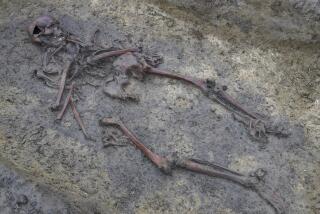Neanderthals put time and effort into burying their dead, study finds
Stocky, sturdy and strong, Neanderthals may also have been sentimental. A new study suggests our closest, extinct human relatives took the time to bury their dead as much as 50,000 years ago.
The findings, published in the journal PNAS, add to a picture of Neanderthals as being more culturally sophisticated than previously believed.
“For years there was a huge debate among anthropologists about how complex the Neanderthals’ thoughts actually were,” said William Rendu, lead author of the study and a researcher at the Center for International Research in the Humanities and Social Sciences in New York. “We knew the Neanderthal was a good tool maker, but there was nothing that linked them to art or symbolic thought.”
The idea that Neanderthals deliberately buried their dead was first floated back in 1908. In August of that year the remains of a male Neanderthal were discovered in a small cave in the town of La Chapelle-aux-Saints in southwestern France. He was found lying in a pit that looked as if it had been dug deliberately (see the photo gallery above), leading researchers to suggest that intentional burials may have been part of Neanderthal culture.
Since then, as many as 40 potential Neanderthal burial sites have been discovered across a wide swath of the world ranging from southeast Spain to Mongolia.
However, not everyone believe these places are truly Neanderthal burial sites. There have been questions from the scientific community about the accuracy of the excavation of the burial site in 1908 and suggestions that the Neanderthals did not have the cognitive ability to choose to bury their dead.
To find out, Rendu and his team reexamined the original cave in France in 1999 to see what they could learn using modern archaeological techniques. Over the course of a 13-year-study, they found several lines of evidence to suggest that this Neanderthal burial site was real and that the burial was intentional.
The pit where the remains were found was clearly not a natural part of the cave floor, and digging it would have taken a lot of time and effort on behalf of other Neanderthals, Rendu said in an interview. The researchers also note that both reindeer and bovine bones were found in the cave, but they were more deteriorated than the Neanderthal bones, suggesting the Neanderthal had been covered up quickly and completely.
He added that the quick burial was not just a speedy way to get rid of a decaying body.
“If they just wanted to get the body away from them, they just had to put it in the open air and the carnivores would have eaten it,” he said. “Instead they removed a large quantity of sediment. It took a very long time for them to do, and it was not essential to their survival.
“If we look carefully, we find the Neanderthals may have had some symbolic or spiritual thoughts that were not needed just to survive,” Rendu said.
In the future, Rendu would like to see the other possible Neanderthal burial sites reexmained using modern science, to determine if they truly are burial sites are not.
For a look at the cave, the burial pit and the excavation, click through the photo gallery above.
Neanderthal burial practices are just the beginning! Follow me on Twitter for more science stories.
ALSO:
Neanderthals organized their caves around tasks, study says
Fossil teeth study takes bite out of Neanderthal-European link
3,700-year-old wine cellar held booze you might not want to drink







